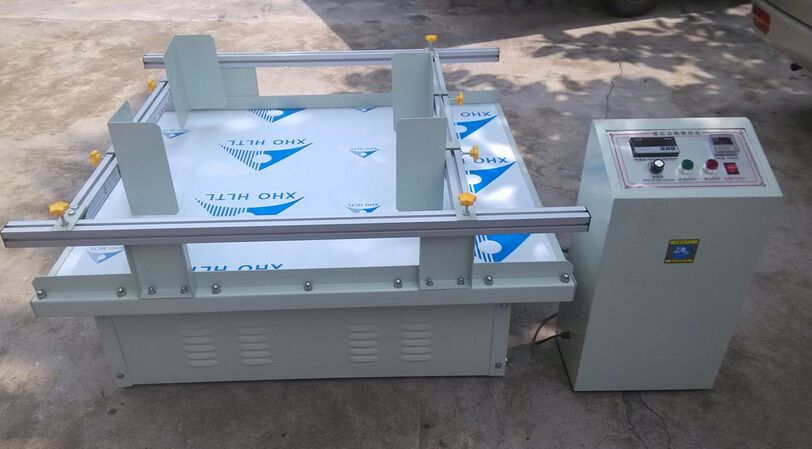ISO 13355-15 Multi-Environment Vibration Test
The ISO 13355 series of standards provides guidelines for testing packaging systems under various environmental conditions. The ISO 13355-15: Multi-Environment Vibration Test is a specialized method designed to simulate the complex vibrations encountered during transport and handling processes. This test evaluates how well a packaging system can withstand these vibrations, ensuring that contents remain undamaged upon delivery.
The multi-environment vibration test is essential for manufacturers of consumer goods, pharmaceuticals, electronics, and other industries where product integrity is paramount. By subjecting the packaging to realistic transport conditions, this test helps identify potential weaknesses in design or materials that could lead to product damage during shipment. This is particularly critical for high-value products like medications, electronic devices, and luxury items.
The test setup involves placing a specimen within a vibration chamber where it undergoes controlled vibration cycles across multiple environments. The ISO 13355-15 protocol specifies the frequency range, amplitude, and duration of vibrations to mimic real-world conditions. Specimens are exposed to various combinations of temperature and humidity levels while being subjected to vertical, horizontal, or combined three-axis vibrations.
The primary objective is to assess the packaging's ability to protect the contents through different stages of transport, including loading/unloading, road, rail, air, and sea travel. The test aims not only at evaluating structural integrity but also considers potential impacts on product quality due to exposure to temperature variations or mechanical stress.
During testing, close monitoring ensures that the specimen remains within acceptable limits defined by industry standards such as ISO 13355-15. After completing each cycle, engineers analyze the results for any signs of damage or failure. If issues are identified early in the process, manufacturers can make necessary adjustments to improve their designs before full-scale production begins.
The importance of this testing cannot be overstated given today's global supply chains which involve numerous transit points and varying environmental factors. A well-designed packaging system that passes the ISO 13355-15 multi-environment vibration test increases confidence in product delivery, enhancing customer satisfaction and brand reputation.
Why It Matters
The reliability of your supply chain directly impacts the success of your business. Ensuring that packaging can withstand rigorous transportation conditions is crucial for maintaining product quality throughout its journey from manufacturer to consumer. Failure at any stage could result in costly recalls, damaged goods, or even legal liabilities.
By incorporating ISO 13355-15 into their testing protocols, companies demonstrate commitment to both environmental sustainability and customer satisfaction. Efficient packaging reduces waste by minimizing the need for additional protective materials during transit. Additionally, successful completion of this test provides valuable insights that can be used to further refine product design and improve overall efficiency.
For organizations looking to expand internationally or enter new markets, passing these types of tests is often a prerequisite. Meeting global standards helps build trust with international partners while also reducing risks associated with cross-border shipments.
In summary, investing in ISO 13355-15 multi-environment vibration testing ensures that your products arrive safely and intact regardless of the challenges posed by modern logistics networks. It supports sustainable practices by optimizing resource usage and promotes long-term business growth through improved brand image and customer loyalty.
Applied Standards
| Standard Reference | Description |
|---|---|
| ISO 13355-15 | Multiaxial vibration test for packaging systems |
| ASTM D4728 | Vibratory testing of flexible containers |
| EN 13355:2019 | Guidelines for packaging systems subjected to multi-environmental conditions |
| IEC 68-2-7 | Vibration testing of electrical and electronic equipment |
The ISO 13355-15 standard defines a comprehensive procedure for conducting multiaxial vibration tests on packaging systems. It specifies the environmental conditions, including temperature ranges, humidity levels, and vibration frequencies, that should be used during testing.
ASTM D4728 focuses specifically on flexible containers but provides useful insights into the principles behind effective vibratory testing. EN 13355:2019 offers broader guidance applicable to various types of packaging exposed to multiple environmental factors simultaneously. Lastly, IEC 68-2-7 addresses similar concerns for electronic devices, providing an additional reference point when evaluating the robustness of packaging intended for such items.
Quality and Reliability Assurance
The ISO 13355-15 multi-environment vibration test plays a critical role in ensuring both quality and reliability throughout every stage of product transport. Properly designed packaging not only protects the integrity of contained items but also contributes significantly to overall supply chain efficiency.
One key aspect of this testing involves assessing how well the packaging maintains its structural integrity under varying environmental conditions. For instance, if a pharmaceutical company relies heavily on temperature-sensitive medications, they must ensure that their chosen container can maintain stable temperatures during transit without causing any adverse effects on the drug's efficacy.
In addition to protecting contents, another important factor in packaging design is preventing leaks or breaches in seal integrity. Leakage can occur due to improper closure mechanisms or insufficient barrier materials used in construction. Through rigorous testing according to ISO 13355-15 guidelines, potential flaws are identified early on, allowing manufacturers ample time to address them before mass production begins.
The test also evaluates whether packaging meets specific performance criteria related to weight distribution and balance stability during transportation. Poorly balanced packages can lead to increased fuel consumption or premature wear on transport vehicles—a costly issue for logistics companies. By adhering strictly to ISO 13355-15 requirements, organizations demonstrate their dedication to optimizing resource utilization while maintaining high standards of safety and efficiency.
Finally, successful completion of the ISO 13355-15 multi-environment vibration test serves as strong evidence that a packaging system is capable of enduring real-world challenges faced during shipping. This certification enhances trust between suppliers and clients by providing assurance about product protection levels. It also helps establish credibility within competitive markets where reputation plays a significant role in determining customer preference.





